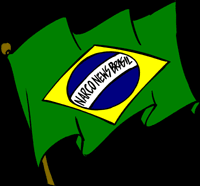


The History of Brazilian Harm Reduction
From AIDS prevention efforts came a broader social movement

By Adriana Veloso
Part VI of a series, reported from Brazil
April 9, 2003
“The first ‘Harm Reduction’ activities in this country happened in Santos, in the State of São Paulo, in 1989,” begins Sueli Santos, the vice president of the Brazilian Harm Reduction Association (ABORDA, in its Portuguese initials). But as a result of the repression by police and other agencies against this pioneering work for most of the 1990s, explains Sueli: “Many people were lost to HIV.”
 Sueli Santos |
“Santos, by that time was a city with many cases of HIV, because of a high level of drug users and because it was a city with a port,” remembers Sueli.
Just as Fortaleza and other cities in the coast, the high level of prostitution and the incoming of drugs in the port city of Santos facilitate the spread of sexually transmitted diseases and the use of drugs on a wider scale than in other parts of the country.
For most of the 1990s, people’s understanding about how HIV (the virus commonly associated with AIDS) was transmitted was very limited.
“My friends would disinfect their toilets after I came to visit them,” recalls Silvio Martins Diniz, who has been HIV-positive for 11 years.
Today, Diniz is the president of the HIV Orientation Group in the city of Rio Verde, in the state of Goiás, where he launched the Harm Reduction projects of his region.
Persecution Under Federal Law
Under Brazilian Law, anyone who foments, helps, or assists, a drug consumer is considered to be a drug trafficker. Thus, in 1989, efforts to distribute clean needles to intravenous drug users – to prevent the sharing of needles and consequent exchange of bodily fluids through which disease can spread – were persecuted by police. “The prosecutor’s office did not allow these activities,” Sueli Santos explains. “They said it was an incentive for people to use drugs. They claimed that we could not prove, scientifically, that the distribution of clean needles was the best way to prevent contamination.”
In 1998, the State of São Paulo passed a new law to protect the efforts of Harm Reduction workers. “The public prosecutors in Santos had pressed charges against many of the professionals who were working in needle-exchange. It accused them of being drug dealers,” notes Sueli. “According to the federal law, giving needles is the same as being a drug dealer.”
 Isabel Chagas |
When, in 1989, Fábio Mesquita, then responsible for the Coordination of the Aids Epidemic Control Program, started to promote needle exchange as a strategy to the HIV epidemic, lauching the first harm reduction project in Brazil, he and David Capistraono, of the city’s Health and Hygiene department, were arrested and prosecuted.
“For an action to be considered a crime,” notes Chagas, “it first must be prohibited by the criminal code. And the intention of the accused must also be considered.” Chagas also notes that in Brazil there is a “necessity defense” in which, for example, it is not considered a crime to defend one’s self.
“In the case of needle exchange,” the barrister continues, “there is no intention to induce drug use. The opposite is true: The intention is to protect people, the same as in the concept of legitimate self-defense. What is the intention of the person who makes a syringe available? The intent is to prevent, to care for public health, and, thus, it is not, or should not be, a crime.”
These are the kinds of questions, Chagas notes, that will be raised by the legal memorandum to the new administration.
But the political and legal mentality that prevailed in São Paulo in 1989 and after was quite distinct: “Everybody remembers the story of the City of Santos. Professionals were afraid to work in Harm Reduction because they didn’t want to be prosecuted as drug dealers,” recalls Sueli, the ABORDA vice president.
Meanwhile, in the Northeastern state of Bahia and other regions, Harm Reduction activities were being developed where there were no applicable laws, says Sueli: “They managed to have a direct contact with drug users that we did not have. But in São Paulo, we needed to work in politics and change the law before anything could happen.”
In 1998, the state of São Paulo passed the new law protecting the Harm Reduction workers. But “the state prosecutors and the police were still enforcing the federal law. Many people were taken to the police station, and their needles were seized by the officers,” Sueli remembers.
 Silvio Diniz llevó la reducción de daños al interior del estado de Goiás |
That was the strategy used by Diniz, in the countryside of the state of Goiás, three years ago when he began the project to prevent STDs and HIV. “In the very beginning,” he says that, “we tried to educate the politicians. We went to speak with the mayor of Rio Verde, Neuci Spodoni, from the right wing PPS party (Popular Socialist Party). She simply replied that HIV was not the priority of her government.”
But just a year later, Rio Verde became the first city in the state to hold a seminar on preventing HIV and STD. “We won this through the education process,” Diniz recalls.
Silvio Martins Diniz, Sueli Santos, and other Harm Reduction workers still find many doors closed to them in trying to inform, as Sueli says, that, “Harm Reduction is a public health activity.”
From HIV Prevention to Social Harm Reduction
“In recent years we have begun to broaden the view of Harm Reduction, not only focusing on needle-exchange programs, but also applying this experience to other regions of the country,” Sueli explains.
One of the advances in Brazilian Harm Reduction came out of the work developed in Ceará, in the Northeast. According to attorney Isabel Chagas, the need soon grew beyond “working with the prevention of illness and harm reduction among drug users,” to becoming more involved with the basic human needs of the populace. “The majority of residents there live in untitled lands with no sewage system” Thus, the Harm Reduction association in Ceará, working with a non-governmental organization known as Casa (the Portuguese initials for the Teenage Counseling Center), began to offer “legal support for those that needed to get off drugs or medical instructions regarding the prevention of diseases.”
Thus, what began as a Harm Reduction movement modeled after the AIDS and disease prevention work in other Western countries became more involved in the social and economic needs of the public. That is when Harm Reduction, as a concept, caught popular fire in Brazil; when it stopped being the “single issue” work as defined by international non-governmental or government organizations, and began answering to the human needs of the public – drug users and others – that the movement had been developed to serve.
In other words, the Brazilian Harm Reduction movement began to consider the public’s needs and desires in the expansion of its own agenda. This has not only opened a path for a more expansive and responsive view of the economic issues driving so many drug use and abuse questions, but, also, has led the Brazilian Harm Reduction movement to more aggressively challenge the prohibitionist premises of the drug war: The movement, in sum, became politicized.
Brazil is a huge country. Each region has its own characteristics, and develops its unique model of public health work. The public support is strong enough so that even the national government’s Health Ministry has begun to support these efforts.
But the autonomy of regional efforts, and the solidarity in sharing the experiences, explains Sueli Santos, is central to the national success. “In São Paulo, and in Bahia, there is a lot of crack use. In other cities, we have other kinds of injected drug use, such as silicone (among transsexuals to spur increases breast size and that of other body parts) and anabolic steroids,” she explains. Clean needle-exchange, to impede the spread of diseases, is vital no matter what drug is being injected.
This example is just one of the aspects of the harm reduction movement in Brazil that will be detailed in this ongoing Narco News series. Of the 15 frontline Harm Reduction workers so far interviewed, at length, for this series, all strongly favor a new national law that protects and accepts the work of Harm Reduction workers and to establish partnerships with the government and others to broaden the work.
Sueli Santos thinks there is still a lot to be done. “We have around 150 harm reduction projects in the country. This is still very few,” she emphasizes, “for such a big country.”
A Drug Policy from Below
Read Part II of this Series:
Drug Users and Addicts are “Self-Organizing” in Brazil
Read Part III of this Series:
130 Drug War Opponents Gather in São Paulo
Read Part IV of this Series:
Brazil Health Official Slams Current Drug Policy
Read Part V of this Series:
The Marginal Diplomat Explains “Organized Crime” in Brazil
Read Part VII of this Series:
“President Lula, listen to the experience of your countrymen!”
Read Part VIII of this Series:
The Marketing of Drug War Myths
Lea Ud. el Artículo en Español
Leia este artigo em português
- The Fund for Authentic Journalism
For more Narco News, click here.




